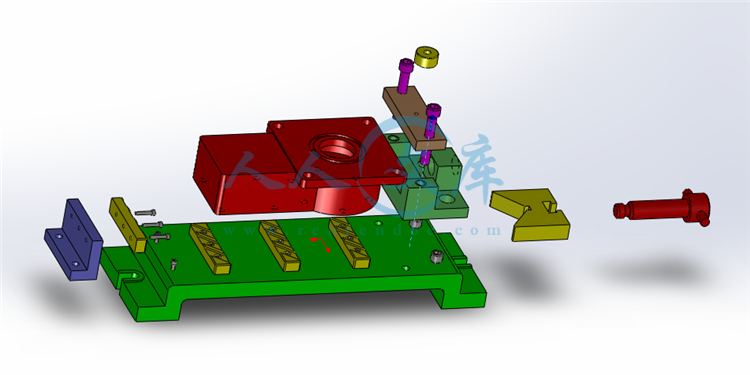!【包含文件如下】【夹具设计类】CAD图纸+word设计说明书.doc【需要咨询购买全套设计请企鹅97666224】.bat
3D
A4 支承板.dwg
参考2.docx
夹具体.dwg
对刀块.dwg
工艺路线.dwg
毛坯图——A1.dwg
说明书.doc
阀腔铣端面夹具装配图.dwg
阀腔零件工艺过程卡与工序卡.doc
零件图.dwg
阀腔工艺规程制定与夹具设计
摘 要
本次设计内容涉及了机械制造工艺及机床夹具设计、金属切削机床、公差配合与测量等多方面的知识。
阀腔零件的工艺规程及铣工件上端面及钻、攻M12螺纹的工装夹具设计是包括零件加工的工艺设计、工序设计以及专用夹具的设计三部分。在工艺设计中要首先对零件进行分析,了解零件的工艺再设计出毛坯的结构,并选择好零件的加工基准,设计出零件的工艺路线;接着对零件各个工步的工序进行尺寸计算,关键是决定出各个工序的工艺装备及切削用量;然后进行专用夹具的设计,选择设计出夹具的各个组成部件,如定位元件、夹紧元件、引导元件、夹具体与机床的连接部件以及其它部件;计算出夹具定位时产生的定位误差,分析夹具结构的合理性与不足之处,并在以后设计中注意改进。
关键词:工艺、工序、切削用量、夹紧、定位、误差。
The planning process and fixture design
Abstract
This design involves the machinery manufacturing process and fixture design, metal cutting machine tool, tolerance and measurement and other aspects of knowledge.
Parts of the process and the valve cavity milling on surface and drilling, tapping the M12 thread fixture design process design, including the parts processing process design and fixture three. In the process of design should first of all parts for analysis, to understand the parts of the process to design blank structure, and choose the good parts machining datum, design a part of the process route; then the parts of each step of the process dimension calculation, is the key to determine the process equipment and cutting the amount of each working procedure design; then the special fixture fixture design, selection of the various components, such as the connecting part positioning element, clamping elements, guiding elements, fixture and machine tools and other components; the positioning errors calculated fixture positioning, analysis the rationality and shortcoming of the fixture structure, pay attention to improve and design in later.
Key words: Technology, process, cutting dosage, clamping, positioning, error.
目录
第1章 绪论 1
1.1引言 1
1.2机械加工工艺规程的作用 1
1.3阀体常用的材料说明 1
1.4课题背景及发展趋势 2
第2章 工艺规程设计 3
2.1毛坯的制造形式 3
2. 2零件分析 3
2.3 基面的选择 4
2.3.1 粗基准的选择原则 4
2.3.2精基准选择的原则 4
2.4制定工艺路线 5
2.5机械加工余量、工序尺寸及毛坯尺寸的确定 6
2.6确定切削用量及基本工时 8
第3章 阀体的夹具设计 24
3.1铣床夹具设计 24
3.1.1定位装置的设计 24
3.1.2夹紧装置的设计 25
3.1.3夹具体的示意图、装配图 25
结 论 30
致 谢 31
参考文献 32














 川公网安备: 51019002004831号
川公网安备: 51019002004831号